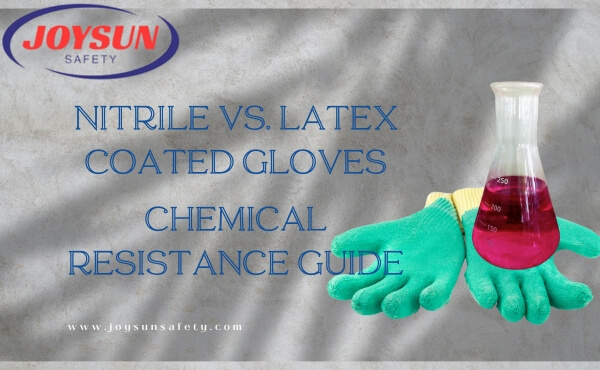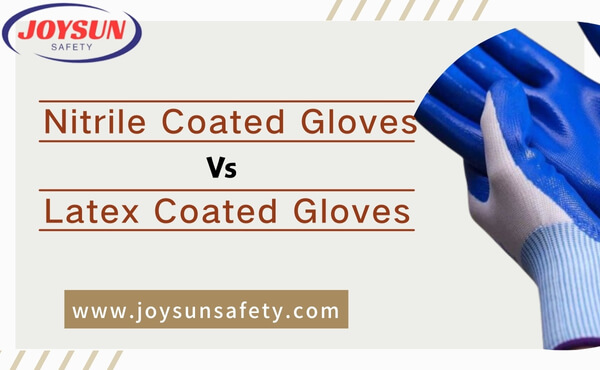Glove durability and lifespan are critical considerations across various industries. This article provides a detailed comparison of nitrile coated and latex coated gloves, guiding readers toward informed decisions for their specific applications. Understanding these differences helps users select the most suitable gloves for their needs.
Overview of Nitrile Coated Gloves
Material Composition
Nitrile coated gloves are made from acrylonitrile-butadiene rubber (NBR), a synthetic rubber offering superior chemical resistance compared to natural rubber. Nitrile provides excellent protection against oils, acids, and other chemicals, making it ideal for various industrial applications. Nitrile coated gloves are also suitable for individuals with latex allergies.
Manufacturing Process
The manufacturing process of nitrile coated gloves involves blending NBR with additives for strength and elasticity, dipping glove forms into the nitrile solution, and then curing and drying for durability. This results in dipped gloves offering reliable protection and flexibility.
Durability Factors
Nitrile coated gloves are known for exceptional puncture and tear resistance. Independent lab tests have shown that nitrile coatings can withstand up to three times the puncture force of comparable latex coatings, making them a more durable choice for handling sharp objects. The nitrile coating provides a robust barrier against sharp objects and abrasive materials.
Nitrile coated gloves perform well in various environments, offering excellent chemical resistance, reliable protection in oily and greasy conditions, and maintaining their integrity in hot and cold temperatures. The thicker nitrile coating may impact breathability compared to latex coated gloves.
Lifespan Considerations
The average lifespan of nitrile coated gloves varies depending on the application, ranging from weeks to months in industrial settings. For example, in a manufacturing setting involving metal stamping, nitrile coated gloves typically last longer than latex coated gloves due to their superior resistance to punctures, tears, and oils. The actual lifespan of both types can vary significantly depending on usage intensity, specific work conditions, glove quality, and maintenance practices. In medical and laboratory environments, disposable nitrile gloves are typically used for single-use purposes.
Several factors affect the longevity of nitrile coated gloves: exposure to harsh chemicals and abrasive materials, storage conditions, regular inspection, and proper fit.
Benefits and Drawbacks
- Superior chemical resistance due to nitrile butadiene rubber (NBR).
- Excellent puncture resistance, offering greater protection compared to latex coated
- Hypoallergenic, suitable for individuals with latex allergies.
- Temperature resistant, ensuring versatility across different environments.
- Enhanced grip.
- Durable and long-lasting, reducing replacement frequency.
- The thicker nitrile coating may reduce tactile sensitivity compared to latex coated gloves, potentially affecting tasks requiring fine motor skills.
- Manufacturing process may not be as environmentally friendly as natural latex.
- Higher cost than latex coated
- Stiffness may lead to hand fatigue during prolonged use.
Overview of Latex Coated Gloves
Material Composition
Latex coated gloves consist of natural rubber latex, providing excellent elasticity and flexibility. Latex offers good resistance to many chemicals but can cause allergies in some individuals.
Manufacturing Process
The manufacturing process of latex coated gloves involves harvesting natural rubber, processing and cleaning the latex, mixing with additives, dipping glove forms, curing, and drying. This results in latex palm coated work gloves that provide excellent grip and protection.
Durability Factors
Latex coated gloves offer good resistance to punctures and tears, although less than nitrile coated gloves.
Latex coated gloves perform well in various environments, offering good resistance to many chemicals and providing a secure grip in both dry and wet conditions. However, they may degrade when exposed to oils and solvents. The thin latex coating allows for good breathability and flexibility.
Lifespan Considerations
The average lifespan of latex coated gloves varies significantly depending on the application and the glove’s specific construction. Industrial Settings: While some durable latex coated gloves may last for years with proper care, they generally have a shorter lifespan than nitrile coated gloves in demanding environments.
Factors affecting the longevity of latex coated gloves include exposure to oils and solvents, storage conditions, regular inspection, and proper fit.
Benefits and Drawbacks
- Excellent elasticity and flexibility, ensuring a comfortable fit and precise hand movements.
- Latex itself is known for tactile sensitivity, but the thin coating on these gloves may reduce this benefit to some degree.
- Good resistance to many chemicals, enhancing versatility.
- Thin coating enhances grip in both dry and wet conditions.
- Lower cost than nitrile coated
- Potential for latex allergies.
- Lower puncture resistance compared to nitrile coated
- Degradation when exposed to oils and solvents.
- Shorter lifespan in harsh conditions.
- Flexibility may lead to hand fatigue during prolonged use.
Comparative Analysis
Durability Comparison
In a standardized abrasion resistance test (ASTM D3389), nitrile coated gloves consistently outperformed latex coated gloves. The nitrile gloves showed less wear and tear after a set number of abrasion cycles, demonstrating their greater durability.
A study conducted in a large automotive assembly plant found that workers using nitrile coated gloves experienced 40% fewer glove failures compared to those using latex coated gloves over a three-month period. The nitrile gloves better withstood the demands of tasks involving sharp metal parts and oily surfaces.
Lifespan Comparison
While the exact lifespan can vary, a general guideline suggests that nitrile coated gloves last approximately 2-3 times longer than latex coated gloves under similar working conditions and levels of stress.
A construction company specializing in roofing reported a significant decrease in glove-related expenses after switching from latex coated gloves to nitrile coated gloves. The nitrile gloves’ longer lifespan resulted in fewer replacements, ultimately saving the company money.
Cost Efficiency
Although nitrile coated gloves may have a higher upfront cost, their extended lifespan often translates to a lower cost per use compared to latex coated gloves, especially in demanding environments where frequent replacement is necessary.
Investing in higher-quality nitrile coated gloves, despite their higher initial price, can lead to long-term cost savings due to reduced glove consumption and a lower risk of workplace injuries related to glove failures.
Suitability for Different Applications
Industrial Use Cases
Nitrile coated gloves are well-suited for industrial environments where workers handle sharp objects and abrasive materials. Latex coated gloves can be used in industrial settings when flexibility, comfort, and a secure grip are priorities, but their limitations with oils and solvents should be considered.
Medical and Laboratory Applications
Nitrile coated gloves are widely used in medical and laboratory settings due to their hypoallergenic nature, chemical resistance, and durability. Latex coated gloves are less common due to allergy concerns, but may be preferred for tasks requiring precise tactile sensitivity.
General-Purpose Use
Both nitrile coated and latex coated gloves can be suitable for general-purpose applications, with the choice depending on the specific tasks and potential exposure to chemicals.
Practical Considerations
Comfort and Fit
User feedback on comfort and fit varies depending on individual preferences and specific tasks.
Both nitrile coated and latex coated gloves incorporate ergonomic features for comfort and fit.
Environmental Impact
Latex coated gloves have an environmental advantage due to the biodegradability of natural rubber. Nitrile coated gloves, being synthetic, do not biodegrade as readily.
Recycling options exist for both glove types, but are more common for latex.
Safety and Compliance
Regulatory Standards
Both nitrile coated and latex coated gloves must meet regulatory standards set by organizations like OSHA and the FDA.
Certification Requirements
Certification validates glove quality and safety. Nitrile coated gloves often have certifications for chemical resistance and puncture protection, while latex coated glove certifications focus on elasticity, comfort, and tactile sensitivity.




















